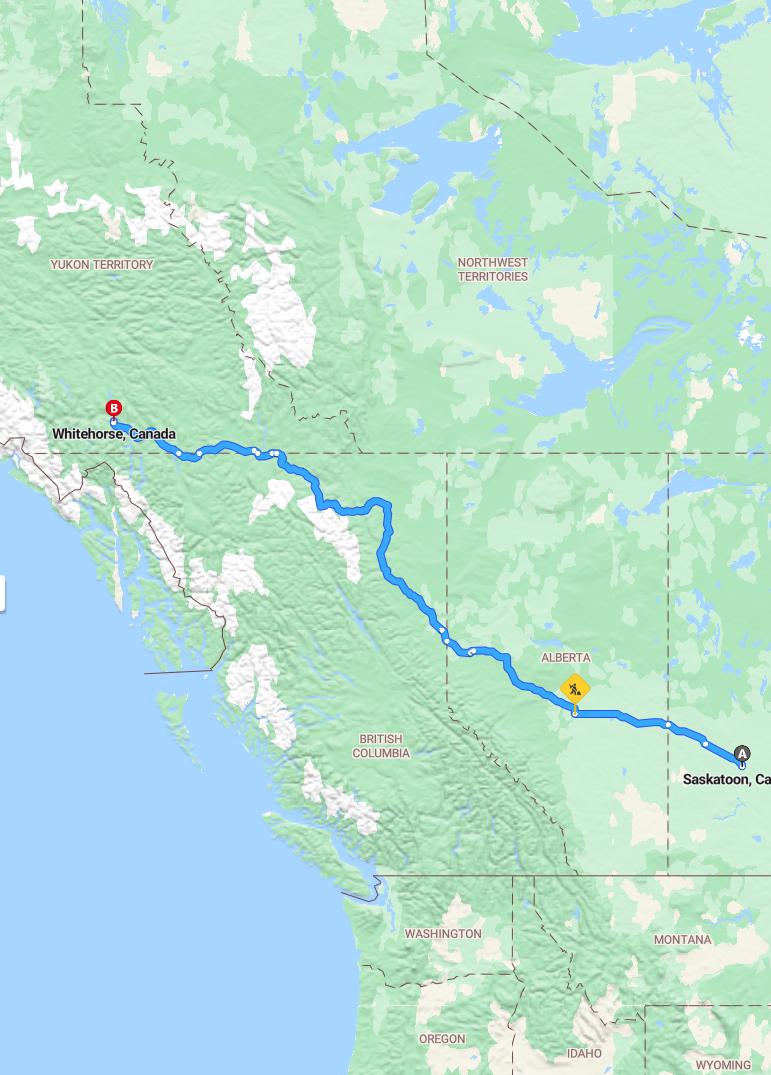Distance and estimated driving time
The drive from Saskatoon to Whitehorse spans approximately 1,558 miles, taking around 25 hours and 28 minutes. This scenic route primarily follows TC-16 W and BC-97, providing travelers with stunning views of Canada's vast landscapes. Planning ahead is essential for such a long journey, ensuring rest stops and accommodations along the way. This route offers an adventurous and memorable experience through the heart of Western Canada and into the Yukon.
Driving route
Embarking on a road trip from Saskatoon to Whitehorse offers an incredible journey through diverse Canadian landscapes. Starting in Saskatoon, travelers traverse the vast plains of Alberta, renowned for its rich natural beauty and vibrant cities. Continuing westward, the route advances through the scenic vistas of British Columbia, characterized by towering mountains and lush forests. The journey then crosses into Yukon Territory, where rugged wilderness and historical sites await exploration, culminating in the city of Whitehorse. This epic drive showcases the raw splendor and geographic diversity of Canada, making it a memorable adventure for travelers seeking natural beauty and cultural experiences.

Road conditions and seasonal considerations
Traveling from Saskatoon to Whitehorse involves crossing several provinces and territories, each with distinct road conditions and seasonal considerations. In the spring and fall, drivers should prepare for variable weather, including rain and occasional snow, which can impact visibility and road traction. During winter months, icy and snow-packed roads are common, requiring appropriate tires, chains, and cautious driving. Summer travel generally offers more stable conditions, but travelers should remain vigilant for road construction and wildlife on less developed routes through northern territories.
Important travel checkpoints and rest stops
Traveling from Saskatoon to Whitehorse involves key checkpoints and rest stops to ensure a safe journey across diverse terrains. Notable checkpoints include major cities like Edmonton in Alberta and Prince George in British Columbia, where travelers can refuel, resupply, and rest. Along the route, designated rest areas and service stations are available, especially in populated regions, providing opportunities for breaks and refreshments. As the route progresses through remote areas such as the Yukon Territory and Northwest Territories, planning ahead for fuel and accommodations becomes essential, making strategic stops crucial for a comfortable and safe trip.
Vehicle preparation tips for long-distance trips
Preparing your vehicle for a long-distance trip from Saskatoon to Whitehorse is essential for a smooth journey. Ensure your vehicle undergoes a thorough inspection, including checking tire pressure and tread, fluid levels, and brake condition. Packing emergency essentials such as a first aid kit, spare tire, jumper cables, and basic tools is highly recommended. Additionally, verify that your navigation systems and roadside assistance plans are up-to-date to handle the diverse terrains and remote areas along the route.
Scenic spots and sightseeing opportunities along the route
Driving from Saskatoon to Whitehorse offers a wealth of scenic spots and unforgettable sightseeing opportunities. Travelers can enjoy the breathtaking prairies and rolling hills of Saskatchewan before entering Alberta's stunning Rocky Mountain vistas, featuring pristine lakes and rugged peaks. As you traverse British Columbia, destinations like the Fraser River and Yoho National Park provide awe-inspiring landscapes of waterfalls, glaciers, and diverse wildlife. Continuing into the Yukon Territory and the Northwest Territories, visitors can explore historic Klondike Gold Rush sites, expansive wilderness areas, and the striking landscapes surrounding Whitehorse, making this journey a true feast for nature lovers and adventurers alike.
Weather forecast and potential disruptions
Traveling from Saskatoon to Whitehorse, travelers should prepare for diverse weather conditions along the route. Anticipate cold temperatures, especially in Yukon and Northwest Territories, with possible snowfall and icy roads during winter months, which could lead to hazardous driving conditions. Sudden storms or heavy snowfalls may cause delays or road closures, particularly in mountainous areas of British Columbia and the Yukon. Staying updated with weather forecasts and road condition reports is essential for a safe journey through this northern region.
Accommodation options along the route
Travelers driving from Saskatoon to Whitehorse have a variety of accommodation options along the route, including hotels, motels, and inns in larger towns such as Edmonton, Jasper, and Whitehorse. In national parks and remote areas within Alberta and British Columbia, visitors can find cozy lodges, campgrounds, and RV parks that provide a more immersive experience with nature. As the journey progresses into the Yukon Territory and Northwest Territories, options may be more limited, but there are charming cabins and wilderness lodges perfect for outdoor enthusiasts. It is advisable to book accommodations in advance, especially in peak travel seasons, to ensure comfort and availability on this scenic cross-country trip.
Local laws and driving regulations in different regions
When driving from Saskatoon to Whitehorse, travelers should be aware of varying local laws and driving regulations across regions. In Saskatchewan and Yukon, seatbelt use is mandatory, and strict penalties exist for impaired driving. Alberta and British Columbia enforce specific speed limits, cell phone restrictions, and anti-idling laws to promote road safety. Additionally, in the Northwest Territories and Yukon Territory, drivers must carry adequate vehicle insurance and be prepared for unique conditions such as wildlife crossings and seasonal road closures.
Safety tips for cross-province driving
When driving across multiple provinces from Saskatoon to Whitehorse, safety should be your top priority. Ensure your vehicle is well-maintained, with check-ups before the trip, and carry essential supplies like food, water, and a safety kit. Be aware of varying road conditions, weather changes, and local traffic laws in each region, especially in remote areas such as Yukon and the Northwest Territories. Additionally, plan your rest stops to prevent fatigue, stay updated on weather alerts, and communicate your travel plans with someone reliable for added safety during your journey.
